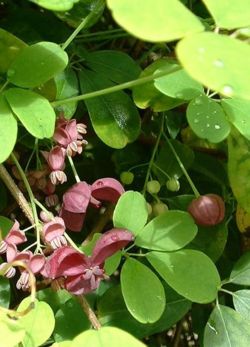| Akebia {{{status}}} Fossil range: {{{fossil_range}}}
|

Akebia quinata
|
| Plant Info
|
| Common name(s):
|
|
{{{common_names}}}
|
| Growth habit:
|
|
{{{growth_habit}}}
|
| Height:
|
⇕
|
{{{high}}}
|
| Width:
|
⇔
|
{{{wide}}}
|
| Lifespan:
|
⌛
|
{{{lifespan}}}
|
| Exposure:
|
☼
|
{{{exposure}}}
|
| Water:
|
☂
|
{{{water}}}
|
| Features:
|
❀
|
{{{features}}}
|
| Poisonous:
|
☠
|
{{{poisonous}}}
|
| Hardiness:
|
❆
|
{{{hardiness}}}
|
| USDA Zones:
|
|
{{{usda_zones}}}
|
| Sunset Zones:
|
|
{{{sunset_zones}}}
|
|
| Scientific classification
|
| Domain:
|
{{{domain}}}
|
| Superkingdom:
|
{{{superregnum}}}
|
| Kingdom:
|
Plantae
|
| Subkingdom:
|
{{{subregnum}}}
|
| Superdivision:
|
{{{superdivisio}}}
|
| Superphylum:
|
{{{superphylum}}}
|
| Division:
|
Magnoliophyta
|
| Phylum:
|
{{{phylum}}}
|
| Subdivision:
|
{{{subdivisio}}}
|
| Subphylum:
|
{{{subphylum}}}
|
| Infraphylum:
|
{{{infraphylum}}}
|
| Microphylum:
|
{{{microphylum}}}
|
| Nanophylum:
|
{{{nanophylum}}}
|
| Superclass:
|
{{{superclassis}}}
|
| Class:
|
Magnoliopsida
|
| Sublass:
|
{{{subclassis}}}
|
| Infraclass:
|
{{{infraclassis}}}
|
| Superorder:
|
{{{superordo}}}
|
| Order:
|
Ranunculales
|
| Suborder:
|
{{{subordo}}}
|
| Infraorder:
|
{{{infraordo}}}
|
| Superfamily:
|
{{{superfamilia}}}
|
| Family:
|
Lardizabalaceae
|
| Subfamily:
|
{{{subfamilia}}}
|
| Supertribe:
|
{{{supertribus}}}
|
| Tribe:
|
{{{tribus}}}
|
| Subtribe:
|
{{{subtribus}}}
|
| Genus:
|
Akebia
Decne.
|
| Subgenus:
|
{{{subgenus}}}
|
| Section:
|
{{{sectio}}}
|
| Series:
|
{{{series}}}
|
| Species:
|
{{{species}}}
|
| Subspecies:
|
{{{subspecies}}}
|
|
| [[{{{diversity_link}}}|Diversity]]
|
| {{{diversity}}}
|
| Binomial name
|
{{{binomial}}}
|
| Trinomial name
|
{{{trinomial}}}
|
| Type Species
|
{{{type_species}}}
|
| Species
|
| See text.
|
[[Image:{{{range_map}}}|{{{range_map_width}}}|]]
|
| Synonyms
|
| {{{synonyms}}}
|
Akebia is a genus of just two species of flowering plant, within the family Lardizabalaceae. The scientific name, akebia, is a Latinization of the Japanese name for the genus, akebi. They are commonly referred to as chocolate vine, and are grown by gardeners as ornamental trailing vines. The purple or reddish purple flowers are borne on racemes and have a slight chocolate scent. Their fruits are edible. The two species have been cultivated into several varieties.
- Akebia quinata (Houtt.) Decne. : five-leaf akebia
- Akebia trifoliata (Thunb.) Koidz. : three-leaf akebia
- Akebia trifoliata subsp. australis (Diels) T. Shimizu
- Akebia trifoliata subsp. longisepala H. N. Qin
- Akebia trifoliata subsp. trifoliata
References
Template:Ranunculales-stub
